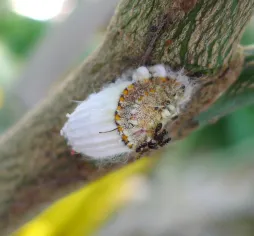Aechmea caudata, a large-format bromeliad
In the Bromeliaceae family, I'd like to talk about... Aechmea caudata! This variety, native to Brazil, is distinguished by its bicolored arched leaves, floral spike and large size.
How to recognize Aechmea caudata?
Aechmea caudata is an epiphytic perennial with a flared habit. It can grow up to 1.2 m high and as wide.
Like aechmea chantinii, this variety is acaule. It has no stem. Its leaves grow in a rosette. They form a central cavity that acts as a water reservoir for the plant. The arching, lanceolate blades are 70 centimetres long and eight centimetres wide. Coriaceous, they are hemmed with black spines. Leaves are bright green with pale yellow margins.
Aechmea caudata flowers only once in its life. An 80-centimetre-high flower spike emerges from the heart of the foliage. A spike sits atop it. It supports an inflorescence of small yellow flowers in a panicle. Flowering generally takes place in summer. It lasts up to six months, after which the plant slowly dies. But it takes time to reproduce, forming shoots at its base.
Aechmea caudata is not a toxic plant. However, it is advisable to wear gloves when handling it. Its sharp thorns can be very cutting.
Our maintenance tips
Aechmea caudata are often sold already in flower. If you're growing offshoots, be patient! It takes three or four years for the plant to flower.
Watering
Always water your aechmea caudata with fresh water at room temperature. Preferably use rainwater.
When watering, pour the water into the heart of the plant, into the reservoir formed by the leaves. Water regularly, but not heavily. Keep the soil moist in summer, but allow the surface to dry out in winter.
Aechmea caudata like to keep two to three centimetres of water at the heart of the rosette. But don't let the water stagnate too long. Before watering, drain off any residual water by tilting the plant slightly.
Spray
Mist foliage with non-calcareous water at room temperature.
Also spray the substrate to keep it slightly moist.
Repotting
Every spring, repot your Aechmea caudata to give it more space.
Choose a pierced pot twelve to fifteen centimetres in diameter. Line the bottom with a bed of clay balls for drainage.
Then add an aerated substrate. You can buy potting soil for bromeliads or mix orchid potting soil, perlite and coconut fibre. Plant aechmea caudata in the center, without burying it too deeply.
To maintain a high level of humidity, place the pot on a dish filled with moist clay balls.
Fertilization
To promote the growth of your Aechmea caudata, apply fertilizer in spring and summer.
Apply green plant fertilizer in addition to watering.
Cleaning
It is not advisable to clean the foliage. Leaves are covered with trichomes, small transparent hairs that capture moisture. They are fragile and can be damaged by dusting.
If your plant gets dusty, it's best to baste the foliage with lukewarm water.
Cutting
Wait until the end of flowering to propagate your Aechmea caudata.
After flowering, your Aechmea caudata produces shoots. You can take them to propagate the plant. When they are about ten centimetres long, you can separate them using your hands or a clean knife.
Prepare a pierced pot adapted to the size of your cutting. Aechmea caudata like to be cramped. The container doesn't have to be large (eight centimetres in diameter is enough), but it should be deep enough to support the weight of the plant without tipping over.
Place a layer of clay balls at the bottom for drainage. Then add a potting soil for bromeliads. You can also make your own substrate by mixing orchid potting soil and green plant compost.
Plant your seedling in the center of the pot. Don' t bury it too deeply. Pack lightly and water with non-calcareous water to moisten the soil.
Cuttings sometimes have trouble standing up straight on their own. You can stake the plant to support it.
Disease / Threat
Information
| Family | Bromeliads - Bromeliaceae |
| Type | Aechmea - Aechmea |
| Species | Aechmea caudata - Aechmea caudata |
| Lifecycle | Perennial |
| Foliage | Evergreen |
| Exposure | |
| Substrat | |
| Planting method |
In pots |
| Categories | |
| Tags |
Beginner Flowery |
| Origin |
South America |
| Hardiness (USDA) | 9b |
| Leaf color |
|
| Flower color |
|
Discover plants from the same family
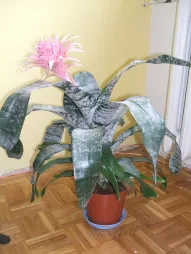
Silver vase
Discover
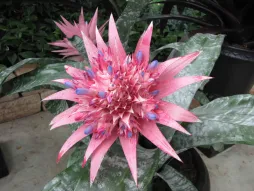
Aechmea Primera
Discover
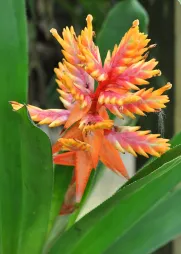
Aechmea 'Pepita Elegant Flames'
Discover
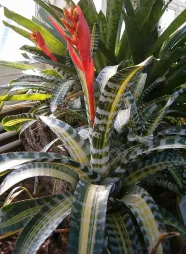
Aechmea chantinii
Discover












